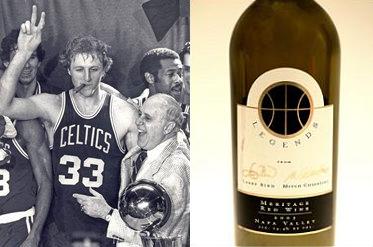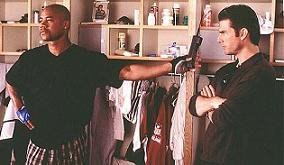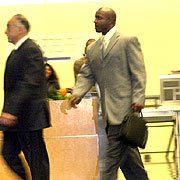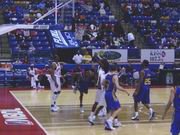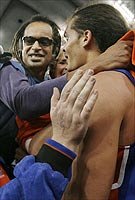But instead, Leinart chose to stay for a fifth year at USC, which had just won a national championship. He reasoned his decision on how much he loved it at USC and the opportunity to win another Heisman Trophy. Many fans praised him for his loyalty. Plus, having grown up in the middle class Californian community of Santa Ana, Leinart may not have had the same immediate financial demands that many similarly-situated players have (although, other than location, I don't know of Leinart's particular upbringing).
Today, while watching the 2006 NFL Draft on ESPN, I watched an increasingly-dejected Matt Leinart sitting in the "Green Room," staring away in disgust as other players were selected ahead of him. ESPN might as well have called it the "Matt Leinart Cam," since it devoted more attention to his reaction than to reaction of those players selected ahead of him. Even worse, Chris Berman & friends had a field day commiserating over Leinart's plight, especially when the Tennessee Titans--whose offensive coordinator, Norm Chow, coached Leinart at USC--took Vince Young instead. And then there was Suzy Kolbern's awkward interview with Leinart's obviously-dispirited agent, Tom Condon, who repeatedly spoke of "getting it over with." The whole escapade may have made for compelling TV and good ratings, but it was done at the expense of a 22-year old and his family. And it lasted until Leinart was chosen 10th overall by the Arizona Cardinals, some 100 minutes after the draft began. But the humilation didn't end there: as ESPN's national audience watched, Leinart then had to answer Kolbern's uncomfortable, skeptical questions about why he may have dropped so far in the draft.
But more than embarrassment, Leinart lost a lot of money. Instead of signing at least a $50 million contract with a $24 million signing bonus, Leinart projects to earn slightly more than what the 10th pick from the 2005 Draft, Mike Williams, signed for ($13.5 million and a signing bonus of about $1.5 million). Plus, instead of playing in San Francisco, where his endorsement income might have been extraordinary, he now goes to a more obscure setting in Arizona. And instead of playing for the storied 49ers and following in the footsteps of Joe Montana and Steve Young, Leinart will instead play for the Cardinals, which have had one of the worst yearly attendance records in the NFL and do not enjoy an inspiring history from which to draw. One might also argue that Leinart's pro career will be one year shorter, although that is speculative for a number of reasons.

Now, I'm sure Matt Leinart enjoyed his last year at USC. He was the proverbial Big Man on Campus, and since he only took one class (ballroom dancing), he undoubtedly had a lot of time to enjoy that status. He also hung out with A-List celebrities and allegedly dated Alyssa Milano. Donald Trump even took a personal interest in him, and Nick Lachey wanted to be his roomate. So life was probably quite good, and he therefore did obtain "value" in a subjective sense by remaining in school.
But was it worth a $40 million difference in contract value, and perhaps $23 million in guaranteed signing bonus money? And was it worth his star falling so hard and so publicly in today's draft? And was it worth passing up an opportunity to play in San Francisco? I'm as much of a fan of Alyssa Milano as any guy, and I'm sure it would be cool to hang out with Jim Carey and Muhammad Ali, but . . . Matt Leinart gave up a lot today.








